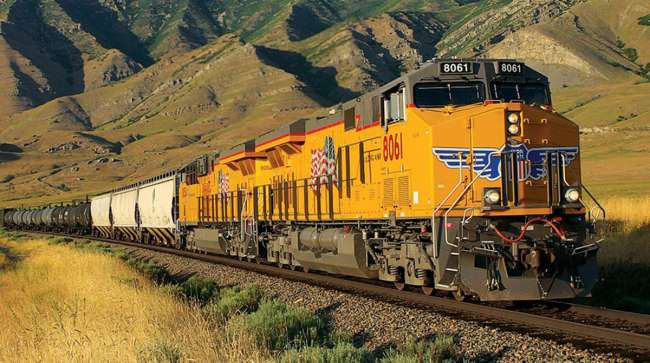Schneider Transitions Western Rail Service to Union Pacific

[Stay on top of transportation news: Get TTNews in your inbox.]
Schneider has completed the transition of its Western rail operations to Union Pacific Railroad, the company announced Jan. 2.
The Green Bay, Wis.-based multimodal transportation provider said the move makes it the largest company driver dray fleet on the rail network. Schneider said it’s a pivotal step in its plans to double its intermodal size by 2030 and continue to reduce its carbon footprint.
“The combination of more coast-to-coast connections and being the first fully asset-based carrier with company drivers, company-owned containers and company-owned chassis to operate on the railroad will result in more consistent service and less time in transit,” said Jim Filter, Schneider executive vice president and group president of transportation and logistics. “We see huge benefits with Union Pacific to successfully deliver a positive service experience for our customers and drivers.”
Schneider has fully transitioned our western rail operations to @UnionPacific!
It's a crucial step toward our goal of doubling intermodal in size by 2030 and continuing to offer our customers more options, consistency, & outstanding service. Learn more: https://t.co/jrZYqliICS pic.twitter.com/ZWW0Oh3DMw — Schneider (@WeAreSchneider) January 3, 2023
Schneider said the transition was the result of collaborating with the rail network over the past year to align operations, technology, sales and customer teams in preparation for the service change. The carrier also reported that process didn’t result in disruption to its customers.

Rocker
“This is the beginning of a partnership built on a shared commitment to provide more sustainable intermodal services and reduce our carbon footprints,” said Kenny Rocker, Union Pacific executive vice president of marketing and sales. “We look forward to future growth as we leverage Union Pacific’s extensive network and Schneider’s innovative logistics offerings to provide unparalleled customer service.”
Schneider said the railroad has additional lane options and consistent rail departure frequency. The carrier noted that this will provide its customers with more options, better reliability and ultimately greater control over the supply chain. The companies also are working collectively to improve driver efficiency at terminals to further reduce delays in transit.
“I think overall it’s clearly a positive,” Stifel analyst Bert Subin said. “I think there was some very minor potential concern that there’d be some disruption as they were doing the transition, but it appears like everything went pretty smoothly. I think part of that is the year runway they gave themselves, making the announcement back in early 2022 and then doing this transition period with clients and with the rails.”
I think there was some very minor potential concern that there’d be some disruption as they were doing the transition, but it appears like everything went pretty smoothly.
Stifel analyst Bert Subin
Subin added that the business also still appears to be on track to double its intermodal size by 2030. Schneider wasn’t a priority intermodal partner when it was working with BNSF Railway. Subin noted that because of that, the ability to get market share growth opportunities was limited. Union Pacific also is investing to increase its intermodal business.
“I think the positive here is Union Pacific is really trying to increase its intermodal positioning,” Subin said. “There’s going to be that ability, perhaps, to add more containers, to be able to get better priority, likely to get better rates than they were getting on BNSF. And so, all of that, you think about the business of intermodal, should be positive on the yield side, should be positive over time on their ability to get a more efficient operation.”

Hoexter
Bank of America analyst Ken Hoexter also pointed out that not being a priority partner with BNSF was hindering Schneider’s ability to compete in the intermodal market. He noted that Union Pacific has been expanding yard capacity and improving access for drivers in preparation for the volume surge to enable a smooth transition.
“With BNSF having a perpetual agreement with J.B. Hunt Transport Services to provide it ‘most favored nation’ status on any lanes BNSF operates on, it was becoming increasingly difficult for Schneider to differentiate its service as it remained behind JBHT in access to BNSF’s network and pricing,” Hoexter said. “This shift should allow Schneider a better footing to compete for intermodal market share, a segment that represents nearly 46% of rail carloads and approximately 25% of rail revenues.”
Subin also pointed out there is overlap with operations extending cross-border into Mexico. Union Pacific has connectivity with Mexico. Schneider has a south-of-the-border business. Subin noted that could present an opportunity for growth.

What is the outlook for trucking in 2023? How will the industry change with the current government, economic and business trends? Join host Michael Freeze and TT reporters Eugene Mulero and Connor Wolf. Hear the program above and at RoadSigns.TTNews.com.
“I think you have to juxtapose, or you have to at least balance that against, a backdrop of softer freight conditions and what happens to spot trucking and how does that influence intermodal in the next several months,” Subin said. “So perhaps you won’t see a significant uptick in the intermodal business as a result of some of those dynamics.”
Subin nevertheless believes that the transition ultimately is going to give the business a good medium-term and long-term growth path. He also anticipates the possibility of some near-term efficiency gains that can help its operating ratios in a downturn.
Schneider ranks No. 8 on the Transport Topics Top 100 list of the largest for-hire carriers in North America, and No. 19 on the TT Top 100 list of the largest logistics companies.
Want more news? Listen to today's daily briefing below or go here for more info:

